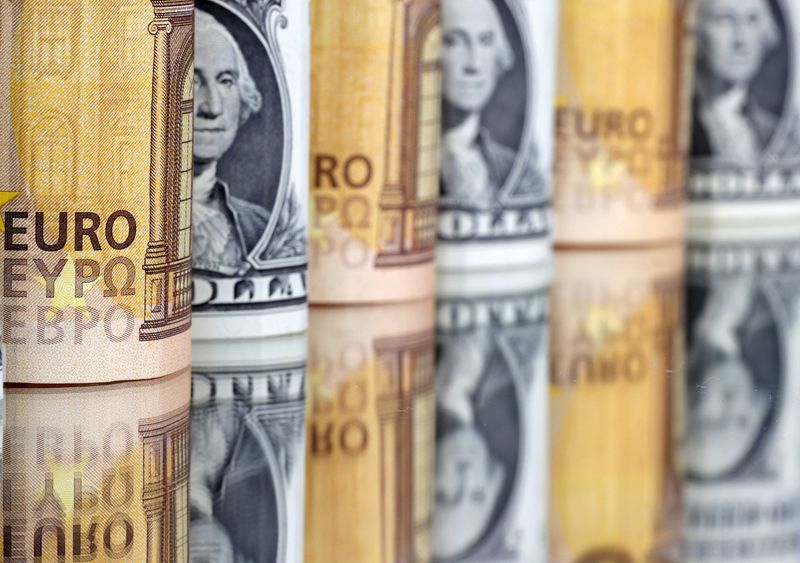Forex
Dollar seeks direction after hitting two-month high, Norwegian crown gets boost


© Reuters. FILE PHOTO: U.S. Dollar and Euro banknotes are seen in this illustration taken July 17, 2022. REUTERS/Dado Ruvic/Illustration
By Hannah Lang and Joice Alves
WASHINGTON/LONDON (Reuters) – The dollar index was off a two-month high Thursday after Federal Reserve meeting minutes left the door open for more rate hikes and data this week indicated a resilient U.S. economy.
The Norwegian crown rose from six-week lows against the dollar and the euro on Thursday after Norges Bank raised interest rates, as expected, and said it was likely to hike again in September.
The was 0.145% lower on the day at 103.300, after hitting a two-month high of 103.59.
The greenback has drawn support from a recent run of U.S. economic data reinforcing the view that interest rates will remain high for some time.
Data on Wednesday showed that U.S. single-family home building surged in July and permits for future construction rose, while a separate report said production at U.S. factories unexpectedly rebounded last month.
Minutes of the Fed’s July policy meeting showed officials were divided over the need for more rate hikes last month, citing the risks to the economy if rates were pushed too far.
“When you come back to the Fed minutes, there is a case for the Fed to hike again in November, but I don’t think the market wants to trade around November just yet,” said Adam Button, chief currency analyst at ForexLive. “There’s so much data between then and now.”
Against the dollar, the Norwegian crown was last up 0.79% to 10.54, having hit 10.66 earlier in the session.
“We do not see the Norges Bank as finished hiking yet and a September rate hike seems all but certain,” said Nick Rees, FX Market Analyst at Monex Europe. Inflation, at 6.4% year-on-year in July, remains too hot for comfort, he added.
DATA DEPENDENT
The Australian dollar steadied after sinking to a nine-month low, taking its New Zealand counterpart along with it, on data showing that Australia’s employment unexpectedly fell in July while the jobless rate ticked higher.
The Australian dollar was last 0.05% lower at $0.642, having tumbled more than 0.9% to a trough of $0.6365 following the employment data release. The fell 0.06% to $0.593 after touching its lowest level since November.
The two antipodean currencies, often used as liquid proxies for the yuan, have also taken a beating over the past few sessions as a result of the darkening outlook over China’s economy.
Elsewhere, the yen edged 0.15% higher to 146.10 after weakening to 146.56 per dollar, its lowest level since November, having come under renewed pressure as a result of interest rate differentials between the U.S. and Japan’s ultra-low rate environment.
The Japanese currency is being closely watched since it touched the key 145 level for the first time in about nine months last Friday, crossing into a zone that sparked an intervention by Japanese authorities in September and October last year.
The euro was up 0.11% to $1.08895, after falling to a six-week low at $1.0862. Sterling was last trading at $1.2754, up 0.17% on the day, after surging on Wednesday on British inflation data.
Despite a sharp drop in Britain’s headline inflation rate, key measures of price growth monitored by the Bank of England (BoE) failed to ease in July, boosting bets the BoE will keep rates higher for longer.
========================================================
Currency bid prices at 10:31AM (1431 GMT)
Description RIC Last U.S. Close Pct Change YTD Pct High Bid Low Bid
Previous Change
Session
Dollar index 103.2900 103.4700 -0.16% -0.193% +103.5900 +103.0500
Euro/Dollar $1.0890 $1.0878 +0.11% +1.63% +$1.0919 +$1.0862
Dollar/Yen 146.1050 146.3550 -0.17% +11.44% +146.5500 +145.6200
Euro/Yen 159.10 159.19 -0.06% +13.41% +159.2900 +158.7900
Dollar/Swiss 0.8781 0.8800 -0.18% -5.00% +0.8809 +0.8760
Sterling/Dollar $1.2753 $1.2733 +0.17% +5.46% +$1.2787 +$1.2704
Dollar/Canadian 1.3509 1.3532 -0.14% -0.27% +1.3552 +1.3497
Aussie/Dollar $0.6422 $0.6424 -0.05% -5.80% +$0.6450 +$0.6365
Euro/Swiss 0.9561 0.9573 -0.13% -3.38% +0.9577 +0.9553
Euro/Sterling 0.8537 0.8547 -0.12% -3.47% +0.8556 +0.8534
NZ $0.5935 $0.5938 -0.06% -6.54% +$0.5963 +$0.5903
Dollar/Dollar
Dollar/Norway 10.5630 10.6200 -0.79% +7.36% +10.6680 +10.5340
Euro/Norway 11.5077 11.5231 -0.13% +9.66% +11.5970 +11.4863
Dollar/Sweden 10.9071 10.8958 +0.08% +4.80% +10.9487 +10.8558
Euro/Sweden 11.8788 11.8690 +0.08% +6.54% +11.8975 +11.8520

 Forex3 years ago
Forex3 years agoForex Today: the dollar is gaining strength amid gloomy sentiment at the start of the Fed’s week

 Forex3 years ago
Forex3 years agoUnbiased review of Pocket Option broker

 Forex3 years ago
Forex3 years agoDollar to pound sterling exchange rate today: Pound plummeted to its lowest since 1985

 Forex3 years ago
Forex3 years agoHow is the Australian dollar doing today?

 Cryptocurrency3 years ago
Cryptocurrency3 years agoWhat happened in the crypto market – current events today

 World3 years ago
World3 years agoWhy are modern video games an art form?

 Commodities3 years ago
Commodities3 years agoCopper continues to fall in price on expectations of lower demand in China

 Economy3 years ago
Economy3 years agoCrude oil tankers double in price due to EU anti-Russian sanctions





















